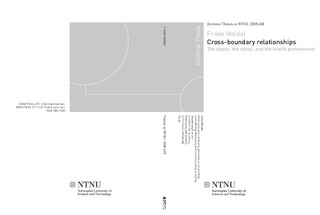| dc.contributor.author | Heldal, Frode | nb_NO |
| dc.date.accessioned | 2014-12-19T14:26:57Z | |
| dc.date.available | 2014-12-19T14:26:57Z | |
| dc.date.created | 2009-04-07 | nb_NO |
| dc.date.issued | 2008 | nb_NO |
| dc.identifier | 211021 | nb_NO |
| dc.identifier.isbn | 978-82-471-1232-8 (printed ver.) | nb_NO |
| dc.identifier.isbn | 978-82-471-1233-5 (electronic ver.) | nb_NO |
| dc.identifier.uri | http://hdl.handle.net/11250/265647 | |
| dc.description.abstract | This thesis is about how health professionals at hospitals collaborate across professional boundaries. Societal and political reforms demand for more transparency and efficiency in health care work, yet history tells us that the professional practitioner resists external accounting. They are not used to open up their professional boundaries for neither insight nor outsight, and too much pressure may risk to strengthen the boundary instead of soften it. Due to the rising complexity in many of these services, there is a growing attention towards how management and patients can account the professionals’ work. This is often combined with the notion that teams comprised of different professions have a great potential in terms of efficiency. Due to these two aspiring developments – claims of interdisciplinarity and accountability – health professionals need to work with an outwardly rather than inwardly focus.
In other words, health professionals need to construct, build and sustain relations and relationships that extend across their professional boundaries. In this thesis, I pursue the empirical quest of how health professionals do this by employing contributions from two theoretical strands. The first strand is that of team/group development and social relationships. I elaborate here on the meaning of sociality and different models of integration in a relationship. The other strand I draw upon insights from, is Science and Technology Studies; and in particular the notion of objects as mediators of social relationships. The concept of boundary object is elaborated upon and argued to be an important asset in cross-boundary collaboration.
Drawing on this theoretical elaboration, added with findings from the papers, I introduce the concept of cross-boundary relationships. A cross-boundary relationship is a relationship that is tightly integrated across the professional boundary. The cross-boundary relationship emerges when health professionals are able to see interactions across the boundary as meaningful, mutually influence and share decisions across the boundary, and finally interpret the boundary itself as an implicit part of the relationship. Boundary objects and social relationships are argued to be an important part of this becoming.
The main contribution of this thesis is to show how health professionals can collaborate cohesively across their professional boundaries. Previous research tend to focus on the work professionals exert to upheld their boundaries, or merely describe interprofessional collaboration at a conceptual level. I show the value in focusing on cross-boundary collaboration rather than boundary work, and model how such collaboration in a practical setting may look like. The concept of crossboundary relationship encompasses this idea. | nb_NO |
| dc.language | eng | nb_NO |
| dc.publisher | Norges teknisk-naturvitenskapelige universitet, Fakultet for samfunnsvitenskap og teknologiledelse, Institutt for industriell økonomi og teknologiledelse | nb_NO |
| dc.relation.ispartofseries | Doktoravhandlinger ved NTNU, 1503-8181; 2008:268 | nb_NO |
| dc.title | Cross-boundary relationships: The object, the social, and the health professional | nb_NO |
| dc.type | Doctoral thesis | nb_NO |
| dc.contributor.department | Norges teknisk-naturvitenskapelige universitet, Fakultet for samfunnsvitenskap og teknologiledelse, Institutt for industriell økonomi og teknologiledelse | nb_NO |
| dc.description.degree | PhD i industriell økonomi og teknologiledelse | nb_NO |
| dc.description.degree | PhD in Industrial Economics and Technology Management | en_GB |

